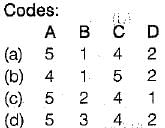Test: Traverse Surveying & Contouring - 2 - Civil Engineering (CE) MCQ
9 Questions MCQ Test - Test: Traverse Surveying & Contouring - 2
The direction of the magnetic meridian is established at each traverse station and the direction of the line is determined with reference to the magnetic meridian. This method of traversing is called
Which one of the following figures indicates the principle of traversing?
If L is the perimeter of a closed traverse, ΔD is the closing error in departure, the correction for the departure of a traverse side of length L1, according to Bowditch rule, is
If the coordinates bf A are 100 N and 200 E and those of Care 100 S end 200 E, then the length AC is
Transit rule of balancing a traverse is applied when
Match List-I with List-II and select the correct answer using the codes given below the lists:
List-l
A. Equally spaced contour lines
B. Contours are always perpendicular to
C. Contours increase in elevation from inside to outside
D. Contours with horizontal equivalent zero
List-II.
1. Steepest slope
2. A vertical cliff
3. A saddle
4. A depression
5. Uniform slope

The contours lines of different elevations can intersect in the case/cases of
1. Vertical diff
2. Cave
3. Over hanging diff
Which of the following methods of contouring is most suitable for a hilly terrain?




















